An Interview with photographer J. John Priola – Part 1
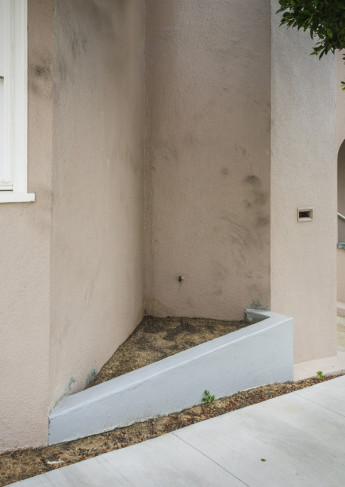
Triangle, 2014
archival pigment print
An exhibit of J. John Priola’s recent photographs just opened at the Paule Anglim Gallery. The show, “Nurture,” reveals the odd corners of the city where a tiny moment or strip of nature has been neglected or mistreated: a tree or bush growing out of control, or just the residue of nature lost.
I met Priola last year and visited him at his home and studio in Glen Park to talk about his personal history and his work. At first we chatted about his experiences up to the time he began receiving recognition for his work. The second part of the interview will cover thoughts on specific images and series.
Q: Did you get interested in photography growing up?
J. John Priola: I was always interested in photography. My mom was a photographer. Well, she wouldn’t call herself a photographer, but she always photographed. She got a little Brownie camera and went to New York in the 1940s, I think, and took all these pictures. She always took slides of the family and trips to the mountains, because we lived in Colorado. So I just picked up the camera.
Do you remember the first photograph that you called a photograph?
Yeah. It was a photograph of a pair of my sister’s shoes. They were platforms, but black and not so chunky. The heel was a little more tapered.
Did they appeal to you aesthetically?
Well, yeah. I think I did little still lives with them. There was the inner leaf of—it might have from a B-52s record. It was green and black leopard print paper—the sleeve that the album fit in. I used that as a background for the shoes. It was a little setup. I wish I had that picture. I didn’t know what I was doing. I was just taking a picture.
So did it keep going in high school?
No. I wasn’t encouraged in high school. Although I did make clay pots. I went to an all-boys Jesuit high school.
Wasn’t creativity encouraged there? The Jesuits have a reputation for encouraging the intellect.
But not for encouraging creativity. The art classes were in a trailer in the parking lot.
Did you come out here for undergraduate school?
No. I wasn’t encouraged to be an artist by my parents either. I grew up on a farm. I remember my mom loading the dishwasher and saying, “You know, you can paint the paintings when you get your own house.” The only time my parents were impressed with my being an artist was when I got in a show in Germany and I was flown to Germany and put up in a hotel. “Oh. Okay, that’s something.”
Did you show inclinations towards being an artist?
Everything I did…I was making something. When I had to irrigate the crops, I would build little houses along what I called a river and there would be floods, because it would erode, and disasters would happen. I was always making up stories, always drawing, rearranging my room. All of the clichés.
Was it subtle how they discouraged you?
I got derailed. You asked about the school. They wanted practicality. So instead of majoring in art originally, I went in with an open idea. Maybe horticulture, because I always liked to grow plants. I didn’t like to farm, which is a very different thing than growing things. Farming is such a hard job. It’s such hard work because you’re dependent on the weather. And in Colorado, it always hailed, and you had to irrigate all summer long. So practicality was an important thing. I went to Colorado State University in Fort Collins, which is an agricultural college. I ended up taking courses to be an occupational therapist. But I got halfway through that and realized kinesiology, neurology, chemistry, no. But I liked psychology, the thinking and the feeling part.
So I transferred to Metropolitan State College in downtown Denver. I still kept doing my electives, and I took a photo class. I realized, “Oh man, this is it. This is making art.” Then I still couldn’t think that I wanted to be an artist, so I went into special education. Then I went into art therapy and said, “Fuck it. Just be an artist. It’s self-indulgent. Just do it.” So I finished my degree there. It took five years because I transferred.
Had your parents resigned themselves?
I think they were resigned.
And how did that twin with coming out?
I never thought about that until this very moment. But I bet part of my parents’ reservation was related to that, too. Maybe it’s just one and the same. I’ve never even separated them. It just all happened at the same time.
Tell me about some of your mentors.
The first photo teacher I had, Barbara Houghton—who I’m still in touch with—she was at Metropolitan State College. I think she’s in Kentucky now, teaching. She encouraged me to go to graduate school. There was also a woman named Jean Schiff. Jean was supportive, but in a whole opposite way. It was a drawing class. She would use my drawings as an example of what not to do. She would hang it up. “This is what you don’t do.”
How was that encouraging?
Well, it pissed me off. Like, “I know I can do it right.” I became insistent and committed that I was going to do it right. So I think between those two—good cop, bad cop—they showed me I could do it.
What subject matters were you exploring in school?
The easiest way to define it is when people think about photography, it’s this whole take and make—take photograph, make photograph. It went so quickly to making a photograph, never taking. I was never a street photographer. Never a documentarian. I would always set up pictures. I always had a hand in how things looked. And that’s changed lately, too. Because your hand doesn’t have to physically be there, but it’s how you construct things in a more open way.
So what were the early constructions?
When I was in college as an art major, I had a friend named Lily Rose, who was a transsexual, I believe. She was also a hairdresser and a DJ. There was this New Wave bar where she was a DJ. Wednesday nights were New Wave night at the Grove. It was so much fun to dress up, and I decided—just like Phil Oakey of the Human League—that I would wear high heels. So I started collecting spike heels from the thrift stores.
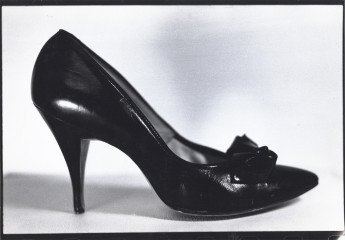
Heel, 1981
gelatin-silver print
That fit you?
Well, mostly. But then I just started collecting them because they looked good. I lived in this corner apartment that had lots of panes in the window, and I hung pairs of shoes in all the panes of the window. I had a huge collection of spiked heels. I started photographing those. I brought them to the steps of the Capitol Building. I brought them out to the farm and put them on the fence with the cows. My mom even helped. She held out a carrot to get the cow to come over near the spiked heels on the fence.
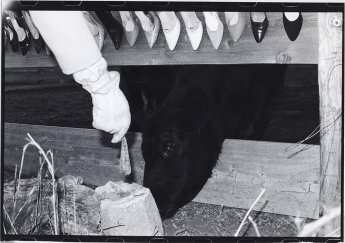
Cows, 1982
gelatin-silver print
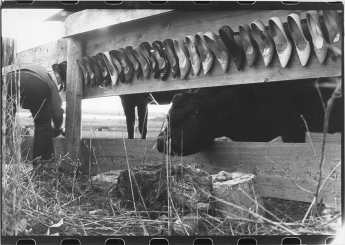
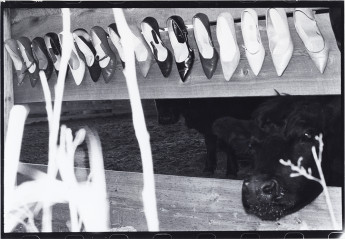
Then I thought I wanted to photograph people. Again, the typical cliché thing is people don’t ever show up. They’re busy. And what are you stuck with? You and your stuff. So I started doing self-portraits. “Self-portrait” is an odd use of the term. The pictures weren’t really about me. At the time, I wasn’t thinking it was a picture about me. It was just what I had, what I could do. But they were so indicative of what I was going through. It was acting for the camera and, oh, it’s embarrassing. Although I love looking at it—but it’s embarrassing at the same time. Such a cliché. Gay men. I had this calendar of Marilyn Monroe, and I cut out the pictures and I put them in a frame and hung it on the wall, and I posed in front of it and took pictures of me.
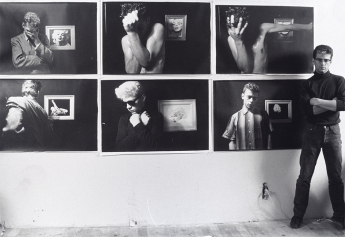
Documentation of work for grad school application.
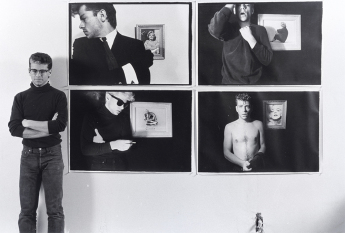
The same pose?
No, no. Different things. Acting out. But one of the shows that I had—Barbara had really encouraged me—my parents came to the show—I got rid of the Marilyn Monroe picture, but I had jewelry, gloves, and a mink collar. I did these shirtless, from mid-torso up with gloves, in color. I printed the picture small on it with white paper, but I would take a penlight flashlight and I would go around with color. It’s not digital. We’re way before digital. This is light.
Then I hung a grid of those up and I got a little glass shelf and I went through all the Vogue magazines and I tore out the scratch-and-sniff inserts. I had piles of scratch-and-sniff cards—so you were encouraged to sniff the perfume while you were looking at these pictures. I still think it’s a stroke of genius.
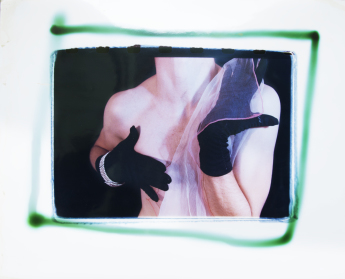
Scratch-n-sniff Gloves, 1981
c-print
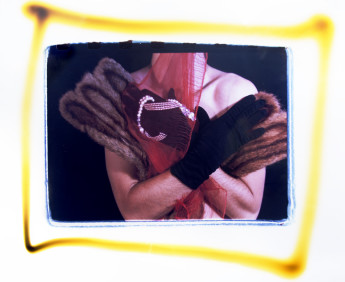
Scratch-n-sniff Mink, 1981
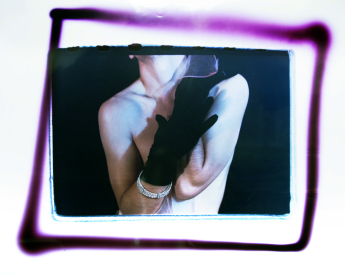
Scratch-n-sniff Bracelet, 1981
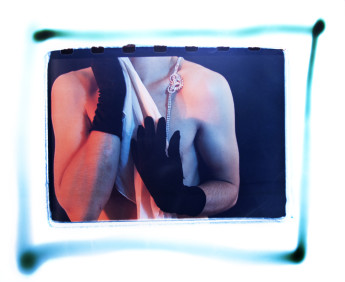
Scratch-n-sniff Necklace, 1981
But were you clearly a male?
Clearly. It wasn’t drag. It was more gender-fuck if anything. But that was not a term for me.
Was your transgender friend an influence then?
She definitely was.
How did your parents react to these images? Did they say anything?
No, they said nothing. In fact, it was more like they ignored it. But at the show, Barb was saying, “He’s really good. He’s really talented. He’s very thoughtful. He really needs to go to graduate school. He needs to go on.” She was very encouraging. And they let me go to school.
So at the same time, they didn’t express negativity?
No. I never got thrown out of the house. None of that, no.
So then what did you do?
Applied to grad school. I applied to CalArts, San Francisco Art Institute, Tyler School of Art, and Chicago Art Institute. And I got into the two California schools, none of the East Coast schools. I went and visited CalArts.
Is that the one in Valencia?
Yes. I think that’s a really good school. I could feel the energy at the time. But it reminded me of the Fort Collins campus, where there are dorms and Led Zeppelin blaring out of the dorm windows and beer cans in the parking lot. This is too much like Fort Collins, Colorado. Bye. I don’t care how good the school is, I can’t live in this environment. And the San Francisco Art Institute was in the city. I had no idea how the city had open arms at the time. It was a weird time, the mid-1980s.
So you came here pretty much right away?
Right out of undergrad.
Your parents actually paid for it?
Yes. While my dad was struggling as a farmer, raising field corn and sweet corn, my mom figured out, “I’m starting a tree nursery so when these kids are in college, these little blue spruce seedlings I’m planting will be big landscape-sized trees and we’re going to make some money for the kids.” And they did. That’s how we all went to school. You got to give her credit.
Blue spruce trees?
Yeah. So when they’re mature, they’re worth hundreds of dollars. It was smart. Because in small family farming, you don’t make a lot of money.
So you came here in the mid-1980s, when AIDS had just hit. I wouldn’t say there was an antigay backlash here, but definitely there was a kind of hysteria. And people were getting sick. So that was a weird time to move to San Francisco.
It was a hard time. But—this sounds very self-centered—grad school is a world in and of itself.
Was it a two-year master’s degree?
Yes. But it took all my time. I put all my energy into it. So yes, there was this whole AIDS crisis happening. Friends of friends were dying. But it was out there, it wasn’t here. I was focusing on school. There was only one other gay student in my year.
In photography?
Photography was very disciplined. It wasn’t interdisciplinary. We weren’t encouraged to mix with other folks. I figured this out three semesters in. “Wait a second. There’s this whole other school. There’s George Kuchar, for God’s sake, working down the hall. Something’s got to give here.” I realized, oh, for your tutorial, if you just get a faculty from another department to agree, you can just do it. They’re not paying attention. So I got some visiting faculty in film and other departments to work with me, and that was a godsend. Because it was outside photography.
Because at the time, I did a series of Henry VIII and his six wives, all with my face. I did it with collage and drawing things. So it was funny. Because it’s so crudely cut out and crudely drawn, but they were Holbeinesque—these tiny little things.
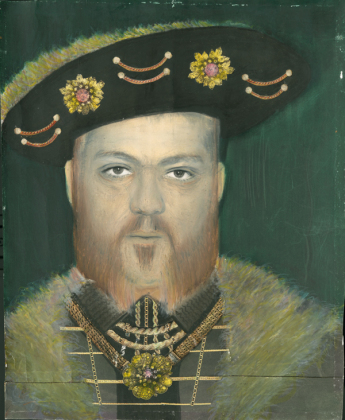
Henry VIII, 1984
gelatin-silver print, collage, hand colored
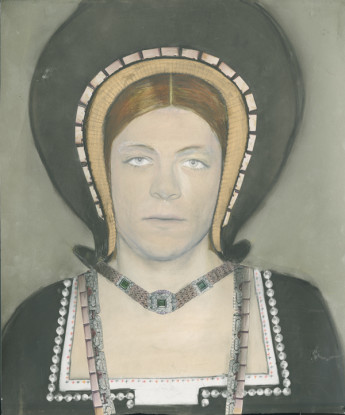
Katherine Howard, 1984
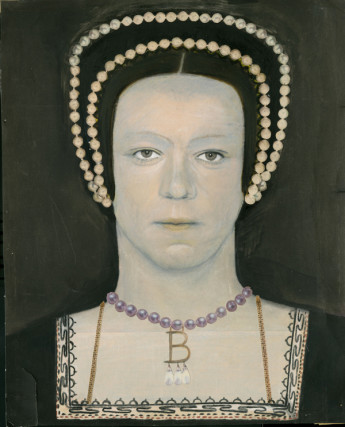
Anne Bolin, 1984
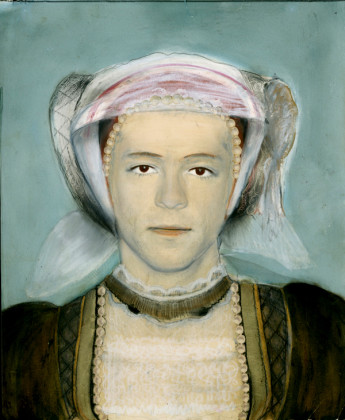
Anne of Cleves, 1984
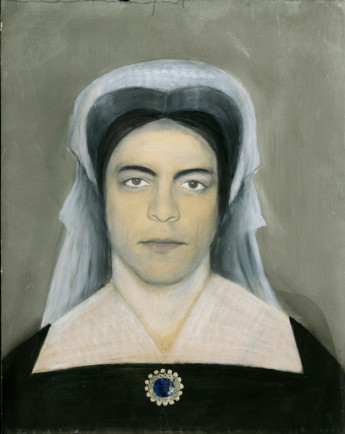
Catherine Parr, 1984
Bringing it around to this AIDS epidemic, the man who helped me—I would buy the frames in a thrift store. He made them into the right size frames. He died so fast of AIDS—and so did his partner.
Who was inspirational at the Art Institute?
Larry Sultan. Hank Wessel. Linda Connor, but for all the wrong reasons. She’s a good friend. But when she was my teacher, she raked me over the coals. But her criticism about how the work was going and it’s so much about the cliché—it was a revelation. I realized, “Yes, it is about the cliché! That’s what I’m interested in.” That’s the nucleus—she was thinking that was the problem, but to me that was the solution.
Did they give you philosophical feedback?
With Larry, all the time. In fact, I would often be listening and I’d think, “You’re full of shit, aren’t you?” But he was thinking and feeling.
So where did the work go, then, during those two years?
It stayed on the self-portrait, and it stayed on this gender thing. But not drag.
A farm boy from Colorado comes to San Francisco. Was that a sort of coming out, coming of age, finding out who you were as a gay person?
I didn’t come in contact with HIV. I could have so easily, but I did not. I get quiet when I think about that. Like, how did that work?
I’m curious about the self and the gender questioning as you’re coming of age in San Francisco. Are they connected?
You know, I’ve thought about this, but not a whole lot. Like, why was that the issue? Why was I so drawn to that, playing both roles?
Both roles?
Male and female. I was reading Jung. I think that gave me permission, in a way. “Yeah, keep thinking about that boy-girl shit. No problem. It’s in there.” But I think it has to do with growing up on a farm and what you’re supposed to do as a man and what you’re supposed to do as a woman. About growing up in such a traditional way.
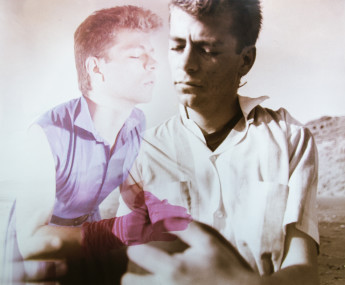
untitled, 1982
c-print
When you don’t have a traditional mind.
And you’re surrounded by it. I’m trying not to be judgmental about it, but my mom followed her husband across the country, Illinois to Colorado. Didn’t know a soul. Lived across the driveway from her new husband’s parents, who spoke Italian in front of her—she doesn’t speak Italian. You don’t do that now. But then, everybody was like, “Here’s what you do. This is the deal. The man does this, the woman does this.” I grew up with that formative thing. But I didn’t have that mind.
What about your family? Did they buy into it?
I have a sister who lives in Santa Fe. She went to Johns Hopkins—as far as she could from Colorado. She got a BS degree there, got a killer job at GE here in San Francisco. Bought a house. Was on her way. But I think she met some pushback as a woman—you know, it was the 1980s. So she found out about this guru and moved to India…the aligning of mind, body and spirit…that freaked my parents out.
More than the gay thing, even?
Yes. Because the gay thing, they could ignore it. How, I don’t know. I mean, look at me. I had a spiked heel collection.
On their fence.
On their fucking fence. Anyway, somehow they ignored it and fixated on my sister moving to India. But it was a little weird, because she was told to get rid of all of her possessions. And instead of getting rid of them, she would write on the back of photographs and mail them as postcards. Like, she wouldn’t really get rid of it. She’d be like, “You throw it out.”
What was the work you were doing as you finished school? What were you looking at?
It’s the gender roles again, and taking the Carl Jung one step forward where he’s not just saying anima and animus, but we’re everything. We’re our own hero, our own heroine, our own saboteur, the whole thing. Instead of doing these black and white typical home photographs, where the woman is cooking at the stove and the man is yelling at the table, or they’re sitting in the little bench all happy, I am doing black and white constructive images I took of classical paintings—like the Tintoretto painting of Bacchus and Venus—and I have set up the scene. What I didn’t photograph, I would draw in. I hand colored, and I worked at a big scale. At that time, there was no Photoshop. It was all done with collage. I would do it on a small scale, rephotograph it with a poor 4×5 camera, and then recolor it. That’s what I was doing as I was leaving school.
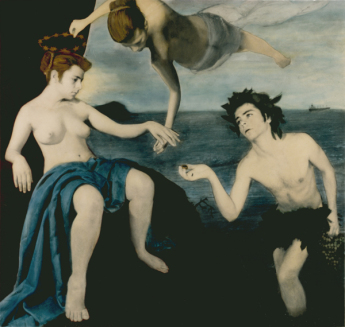
Ariadne Bacchus and Venus, 1988
gelatin-silver print, hand colored
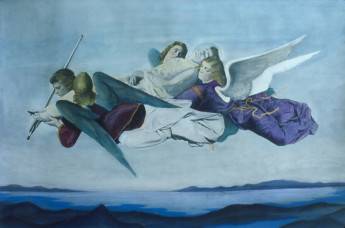
St. Katherine, 1988
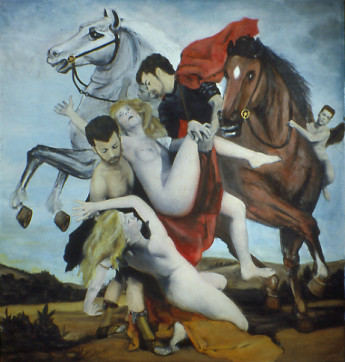
Ruebens, 1988
What do you do with an MFA in photography?
I worked three jobs, and one of them was silk screening and another one was picture framing—which ended up being a 25-year gig. But that dovetailed with the photography, because it’s always allowed me to finish my work in the way I want to finish it.
And your work was often dependent on the frame?
Always. When I started to get noticed as an exhibiting artist here, I feel it was more like a sculpture. I didn’t ever sell just a print. It was framed. Always. That was kind of the deal.
Where did you work as a framer?
It’s called Spot Design. It still exists. Tamara Freedman still runs it, and she became like a third sister to me, working for her all these years. She’s an artist herself but didn’t pursue the exhibiting career, but became a picture framer extraordinaire.
When did people begin to notice you?
At that time, in the late 1980s, this was a different town and a much different art world. There was New Langton Arts, Southern Exposure, Intersection for the Arts, SF Camerawork. All of these places were interested in emerging artists. You could send in an application, and if you were a good artist, you would get a show, a solo exhibition. My first show was at Intersection. Then I got into a group show at the Vorpal Gallery. They had a new director they hired that thought, “Let’s look at some of these new MFA graduates, and let’s have a show.” I think they never wanted to do that again. We were crazy.
After a show, you would be asked to donate a piece for an auction. A catalog would get made and make it around. Jeffrey Fraenkel saw an SF Camerawork catalog, and I was doing these round pictures, and he gave me a show.
Tell me about the round pictures.
Well, they’re in here, mostly, but they’re little still lives like that. Little setups of singular objects.
I’m interested in this work, how you decide on one image or another.
It started out with truisms, kind of like Jenny Holzer, in a way. Life’s a bowl of cherries, the brass ring, the golden egg. So I would write that down, and I would visualize it first. And if it still made me feel good or—I don’t know what the feeling is—still felt that little burning, I would then set up the thing and photograph it. I think why they were still lives is because I never was a street photographer. I never wanted people to watch me photograph. I never wanted people to watch me at all.
I’d set the picture up, and I had a rule. It was three days or something. If I read the word and it still was interesting in three days, then I would do it.
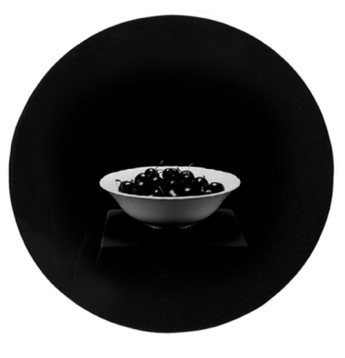
Cherries, 1993
gelatin-silver print
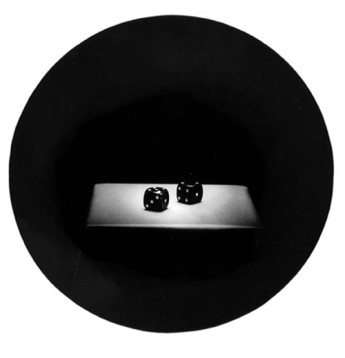
Dice, 1993
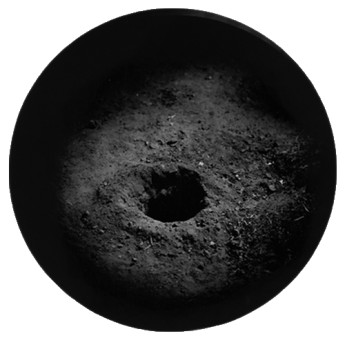
Hole, 1993
So Fraenkel saw a piece in a catalog and gave you a show?
I was riding an elevator in 49 Geary. He rode up to his gallery up with me, and he knew who I was. I think it was because Tamara framed for Fraenkel. I knew who he was. And he said, “I really like your piece in the catalog.” “Oh, thank you very much. There’s more. Would you like to see them?” “Okay.” So I showed him.
Then he gave you an exhibition?
A summer exhibition, which, you know, that’s always the easy way to try somebody out. But people did pay attention. And I had three shows there over several years.
When did digital come in?
I totally ignored it until about seven years ago. My film stopped being made. It was a Polaroid positive and negative film, Type 55.
What did you do?
Tried to reinvent myself, tried to use a different medium. I just kicked and screamed. Then I realized, “I have to embrace this digital thing.” It’s not so bad now. It’s like oil painting and acrylic painting.
So how do you print the photographs?
Digitally. I do use the darkroom for black and white. Anything color is digital. If it’s black and white, it’s all analog. Still a wet process. Film, silver print. If it’s color, I don’t even use film. Just straight digital. A lot of artists still use color film, scan it, and then print it digitally. But I don’t want to attach myself to another film and then have it taken off the market again.
Do you print the digital prints yourself?
Yes. It’s not the fanciest printer. In fact, it’s outdated, but it works. By the time you buy and learn your piece of equipment, it’s obsolete. I also have the luxury of being able to print at school, but I hate it because there are students around.
It’s not private. How did you start teaching at the Art Institute?
You know, it was kind of funny. I think people go to graduate school because they want to be an artist or they want to teach. That’s why they get an MFA. But if you are going to teach, you make your career as a teacher. You need to put a ton of energy into getting that teaching job and doing it. Or you put a ton of energy into your art career, and then you’re asked to teach. Hank, my former instructor, asked me to teach a class. Frankly, it’s because there was a cancellation. Somebody bailed at the last minute. “Who are we going to get? Who do I know? Oh yeah, I’ll call him.” I got a call on a Thursday, “Class is starting next week.” That was 1996, I think.
So were you doing framing and teaching and making art?
I was. I never framed five days a week. I think I did it four, three, and then two, and then bye-bye.
Let’s go look at some pictures.
In Part Two, Priola discusses the process behind some specific works.
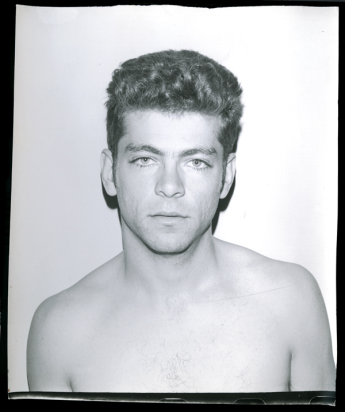
Henry VIII, base image, 1984
gelatin-silver print